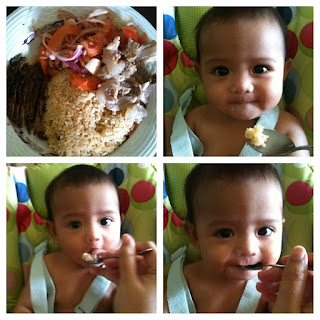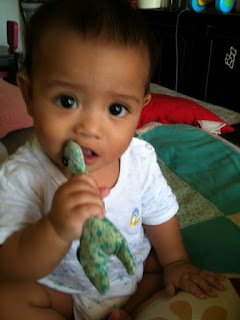here is my world... world which is so small compared to the other created world by Allah... Subhanallah....
Wednesday, February 08, 2012
Jaundice continue...
There is another type of jaundice. That is breast-milk jaundice.
Source from Wikipedia.
Breast milk jaundice
Whereas breast feeding jaundice is a mechanical problem, breast milk jaundice is more of a biochemical problem. The term applies to jaundice in a newborn baby.
First, at birth, the gut is sterile, and normal gut flora takes time to establish. The bacteria in the adult gut convert conjugated bilirubin tostercobilinogen which is then oxidized tostercobilin and excreted in the stool. In the absence of sufficient bacteria, the bilirubin is de-conjugated by brush border β-glucuronidase and reabsorbed. This process of re-absorption is called enterohepatic circulation. It has been suggested that bilirubin uptake in the gut (enterohepatic circulation) is increased in breast fed babies, possibly as the result of increased levels of epidermal growth factor (EGF) in breast milk[5] .
Second, the breast-milk of some women contains a metabolite of progesterone called3-alpha-20-beta pregnanediol. This substance inhibits the action of the enzyme uridine diphosphoglucuronic acid (UDPGA)glucuronyl transferase responsible for conjugation and subsequent excretion of bilirubin. In the newborn liver, activity of glucuronyl transferase is only at 0.1-1% of adult levels, so conjugation of bilirubin is already reduced. Further inhibition of bilirubin conjugation leads to increased levels of bilirubin in the blood [6][citation needed]. However, these results have not been supported by subsequent studies. [7]
Third, an enzyme in breast milk calledlipoprotein lipase produces increased concentration of nonesterified free fatty acids that inhibit hepatic glucuronyl transferase, which again leads to decreased conjugation and subsequent excretion of bilirubin[8][citation needed].
Despite the advantages of breast feeding, there is a strong association of breast feeding with neonatal hyperbilirubinemia and thus risk of kernicterus, though this is uncommon. Serum bilirubin levels may reach as high as 30 mg/dL. Jaundice should be managed either with phototherapy or with exchange blood transfusion as is needed. Breast feeds however need not be discontinued. The child should be kept well hydrated and extra feeds given.
Another web source explains the meaning of breast-milk jaundice, from http://www.americanpregnancy.org/
Breastmilk Jaundice- This is jaundice that persists after physiologic jaundice subsides and is seen in the otherwise healthy, full term breastfed baby. There is no known cause for this type of jaundice although speculation is that it may be linked to something in the breast milk that is blocking the breakdown of bilirubin. (Breastmilk jaundice tends to be genetic and run in families.) Breastmilk jaundice does not mean that something is wrong with the mother's milk and that breastfeeding should be stopped. Most babies who present with true breastmilk jaundice (only 0.5% to 2.4% of all newborns), may see another rise in bilirubin levels at about 14 days, but they will level out and eventually decrease. Breastmilk jaundice can last for 3-12 weeks after birth, but as long as baby is feeding well and bilirubin levels are monitored, it rarely leads to serious complications. Breastmilk Jaundice must also be differentiated from breastfeeding jaundice, which is a lack of milk that results in jaundice, or from any other underlying health conditions.
In my case. My baby was assumed to be "breast-milk jaundice". Since baby was feed only breast-milk and have no issue of not enough supply and nothing was wrong with my milk. My first child had high bilirubin level too after 7 days but then I don't feed her much since no breast-milk until the fourth or fifth day. We mostly feed her with formula milk.
But we still are worried and we proceed for further check-up and treatment. Takut juga if ada masalah lain yang kita tak nampak. My baby was admitted for phototherapy treatment on the fourth day of birth. Due to his bilirubin level hike up to 274.
What I did was then, I don't stop breast feeding my baby and supply milk sekerap mungkin. I breastfeed as long as I could. Since Jaundice is more common in a breastfed baby and tends to last a bit longer. This is to make sure my baby's bilirubin level doesn't hike up. If it hike up more than 400 the hospital will further for other kind of treatment to elakkan more serious possible damage. They will proceed for "Exchange transfusions" treatment. After stages of phototherapy & medications. Tak mau la... Kalau bole elak tu elakkanlah... Since tukar darah nie bukan perkara mudah & bayak risk.
Tengok parents yg terpaksa buat that treatment... X tahu nak describe the situation. Menakutkan... Kesian... Semua ada...
Here some tips for other parents that we use for our baby from http://www.americanpregnancy.org/
What is the Treatment for Jaundice in the Breastfed baby?
If bilirubin levels are below 20 milligrams, the following treatments are often used for breastmilk jaundice and breastfeeding jaundice in the full term, healthy infant:
Increase feedings to 8-12 times a day. The best way to decrease bilirubin levels it to help remove it—increased feedings will increase bowel movements, which will excrete the bilirubin.
Work with a lactation professional to make sure that the baby is latched on the breast well, so that he/she can take in as much milk as needed. Improper latch can directly affect how much milk a baby is receiving.
If a supplementation is recommended to increase baby's calories and intake, work with a lactation professional to use a lactation aid. The mom would also want to pump during this time, to not interrupt the production of her milk. Using a lactation aid to deliver expressed breastmilk or a mixture of breastmilk and formula is the best way to not interrupt the breastfeeding relationship.
Rarely is the interruption of breastfeeding an effective treatment for jaundice in a breastfed baby. If a baby's bilirubin levels reach 20 milligrams or above, a recommendation to cease breastfeeding for 24 hours may be used in conjunction with phototherapy. This can usually drop bilirubin levels dramatically and the mom can then resume breastfeeding as normal after the 24 hour period. Using a lactation aid to deliver supplementation and pumping during this 24 hour period would be the best way to avoid any problems in the breastfeeding relationship.
If phototherapy is recommended (usually only if bilirubin levels reach over 15-20 milligrams), talk with your health care provider about using fiber optic blankets. These can be taken home and allow mom to continue the breastfeeding relationship, with no interruptions. Increased feedings and the use of the bilirubin lights should effectively lower the bilirubin levels.
If a baby is premature or has any other health conditions, the treatment would need to be individualized by the health care provider.
Treatments not recommended for decreasing Jaundice in the breastfeeding infant:
Supplementing with sugar water. In fact, this can cause jaundice to worsen by interfering with breast milk intake, breast milk production and delay the drop in bilirubin levels.
Discontinuing breastfeeding. This can ultimately make jaundice worse and can sabotage a mother's effort to provide her child with the best nutrition possible. Frequent and efficient feedings of breastmilk, is the best way to decrease jaundice.
Can Jaundice in the breastfed baby be prevented?
Jaundice occurs in 50-70% of all newborns, so there is really no way to actually prevent it from occurring. But there are ways to prevent it from becoming serious and reaching a level that requires additional interventions.
Initiate the breastfeeding relationship as soon as possible after birth. Studies show that the breastfeeding relationship has fewer challenges and a higher rate of success when it is initiated in the first hours after birth.
Work with a lactation professional to make sure that a proper latch is achieved and baby is taking in adequate amounts of milk.
Feed the baby frequently in the first days and weeks of life. Don't try to put the baby on a "schedule" until the breastfeeding relationship has been effectively established. If baby is sleepy, work to keep them awake so that they get full feedings.
Avoid supplementing or interruption of breastfeeding if at all possible.
What are the treatment? (source Wikipedia)
The bilirubin levels for initiative of phototherapy varies depends on the age and health status of the newborn. However any newborn with a total serum bilirubin greater than 359 umol/l ( 21 mg/dL ) should receive phototherapy.[9]
Phototherapy
The use of phototherapy was first discovered, accidentally, at Rochford Hospital in Essex, England. The ward sister (Charge Nurse) of the premature baby unit, firmly believed that the infants under her care benefited from fresh air and sunlight in the courtyard. Although this led to the first noticing of jaundice being improved with sunlight, further studies only progressed when a vial of blood sent for bilirubin measurement sat on a windowsill in the lab for several hours. The results indicated a much lower level of bilirubin than expected based on the patient's visible jaundice. Further investigation lead to the determination that blue light, wavelength of 420-448 nm, oxidized the bilirubin to biliverdin, a soluble product that does not contribute to kernicterus. Although some pediatricians began using phototherapy in the United Kingdom following Dr. Cremer's publishing the above facts in theLancet in 1958, most hospitals only began to regularly use phototherapy ten years later when an American group independently made the same discovery.[10][11]
Ok... Alhamdulillah semua selamat... After phototherapy treatment session for 2 days... Turun skit to safe level & bole discharge. Tapi still kene follow up. But later his bilirubin level naik jugak but it is not that dangerous since he has pass that 1 week and his kuning nampak surut walaupun slow... Still pergi check up with doctor from time to time until it fully gone... About 3 month or more... :)
So nasihat for parents out there don't pandai2 give your baby or feed them with benda pelik2 other then your breastmilk or prescribed medicine. Because it can make it worse. But if you want to feed them with air zam-zam or kurma @ delima, I think it is ok. Because I fully believe those have it's own benefits if not they won't be written in quran. But still please consult with doctors.




